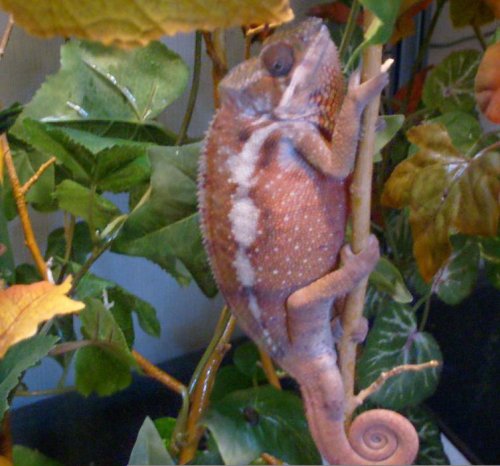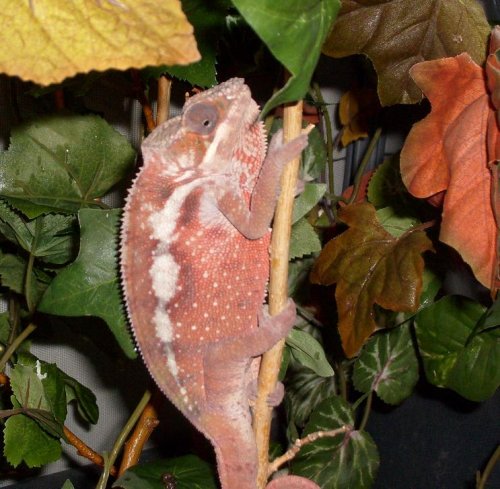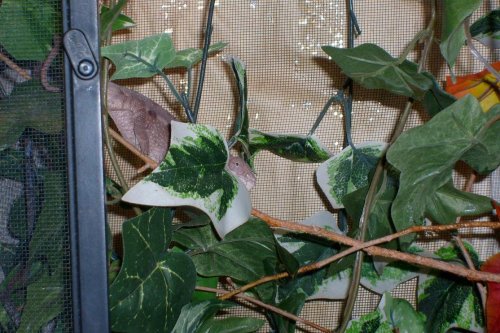Navigation
Install the app
How to install the app on iOS
Follow along with the video below to see how to install our site as a web app on your home screen.
Note: This feature may not be available in some browsers.
More options
You are using an out of date browser. It may not display this or other websites correctly.
You should upgrade or use an alternative browser.
You should upgrade or use an alternative browser.
pics of my sambava
- Thread starter Fate X
- Start date
PardalisGirl
Avid Member
How old?
How old is this fiesty guy?
How old is this fiesty guy?
Chameleons Northwest
Avid Member
Wow, he's a nice chunky guy. Nice meaty legs. Makes our little guy look like a string bean. What does he weigh? Is he fired up in this photo? What are his resting colors?
Chameleons Northwest
Avid Member
There seem to be 4 layers of skin which control the chams colors. The epidermis, which is transparent skin made up of keratin, like our fingernails, and which gets shed. Then the chromatophore layer, containing yellow and red pigment cells. Then the melanophore layer containing melanin, with brownish black and reds, and blues. And then the nether layer which only reflects white. The color cells expand and shrink, producing the various colors we see on the surface. Many cham species have bits of white in their standard coloration. It mimics the bits of light seen when the filtered sun reflects off leaves and petals.
Certain chams will show white regions in response to overheating, extreme stress, or illness.
Your Sambava does show more white than ours does, but yours is younger. My male Sambava has the white lateral stripes (or blotches) and the white "clown" lips (a defense mechanism making him look like he has huge white teeth). Yours looks like he is either starting a shed, or just has more white in his coloration. May just be his youth (not quite come into his colors yet).
What are the temps in his enclosure?
Certain chams will show white regions in response to overheating, extreme stress, or illness.
Your Sambava does show more white than ours does, but yours is younger. My male Sambava has the white lateral stripes (or blotches) and the white "clown" lips (a defense mechanism making him look like he has huge white teeth). Yours looks like he is either starting a shed, or just has more white in his coloration. May just be his youth (not quite come into his colors yet).
What are the temps in his enclosure?
Last edited:
Chameleons Northwest
Avid Member
makes you wonder whats going on with a animal ,he eats great i did add a xtra dome light so it was warm the day i took those pics im gonna take a few more of the pair.
The panthers like it a little cooler than veileds do. Basking temp can be about 85 degrees. I measure mine in place, to be certain of the temp. For veileds it can be between 90 and 100 for basking, but that would probably put a panther cham into stress. I know unusually pale colors can be a sign of heat stress. But from the photos your cham just looks like he has quite a bit of white and pink in his coloring. Perhaps someone who has more experience with the Sambavas can take a look. Our Sambava looks nothing like yours in coloring. But he was 7-8 months old when we purchased him, and already well into his greens and reds. Pam of Pamschams kept his basking temp at about 85 and I do the same.
Last edited:
Fate X
New Member
Chameleons Northwest
Avid Member
hes still young and looks like theres other colors sufacing.these are pics of the female.
ive read 95f for a basking spot for a panther chameleon maybe it is too much heat because he was chilling away from the basking spot.
I know, that's what I had read as well. On the AdCham site, for instance. 95F for basking. But Pam and also Pardalisgirl hooked me onto the 85 degree range and it seems to be working very well. They use 50Watt basking bulbs in the warmer months, and higher in the cooler months. But they live up in the northwest, as I do.
Have you read the description of the Moroansetra? They are said to be nearly identical to Sambavas, except for these differences (the description resembles the coloration of your male):
"Moroansetra: This orange- red morph has one of the largest body size of the morphs of F. pardalis. They are typically orange (to red) and white with some black striping when stressed or breeding. At rest, they are ox blood color with green and white with vertical bars faint or absent. The dorsal body is usually lighter and forms a distinct light gray or bluish longitudinal stripe. Eye turrets can be black and gray when displaying to a female or rival male. Climate: Avg. 144 inches/yr. rainfall (366 cm). Temperatures average 26ºC (high) and 20.8ºC (low). "
According to that the Moroansetra's temps range from about an 80 degree high to about a 68 degree low, in real life.
Fate X
New Member
ive never read that so your saying monestra is tamative the more comon name.
ive have not seen many tamative panthers ,he dont look like one.
when he runs etc. i can see orange maybe yellowish stripes surfacing that would make me happy, i really dont know exactly what both are because i have know knowledge of what pure sambava are.i trust the source i mean i thought he was a girl n they made a mistake but i was wrong.
so what i have to go with is they are both sambava and whatever they create is what it is.im gonna buy 1 or 2 more next year.
you said 85f for a basking area whats the coldest yours ever been?
ive have not seen many tamative panthers ,he dont look like one.
when he runs etc. i can see orange maybe yellowish stripes surfacing that would make me happy, i really dont know exactly what both are because i have know knowledge of what pure sambava are.i trust the source i mean i thought he was a girl n they made a mistake but i was wrong.
so what i have to go with is they are both sambava and whatever they create is what it is.im gonna buy 1 or 2 more next year.
you said 85f for a basking area whats the coldest yours ever been?
Similar threads
- Replies
- 10
- Views
- 652
- Replies
- 17
- Views
- 383
- Replies
- 3
- Views
- 564





